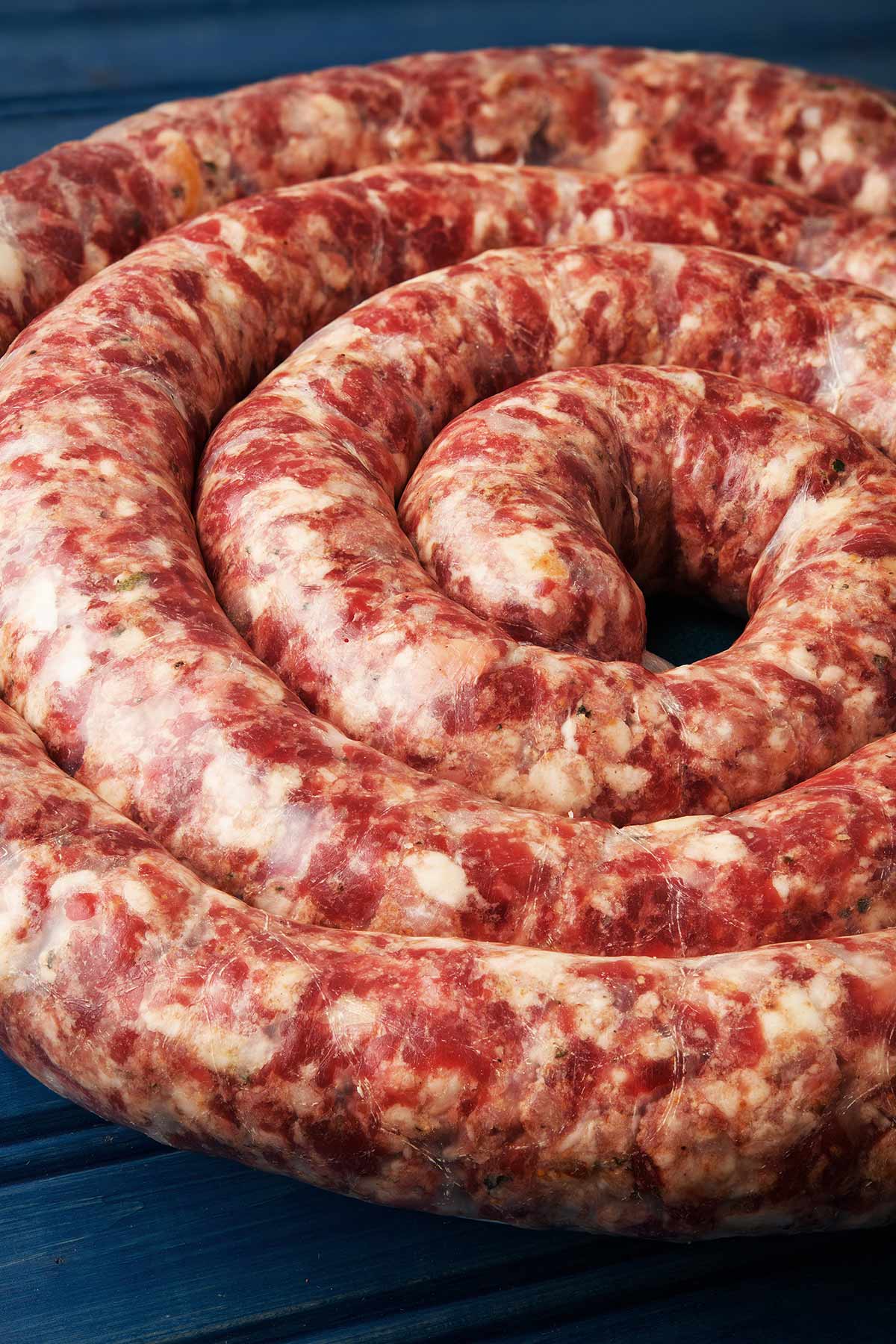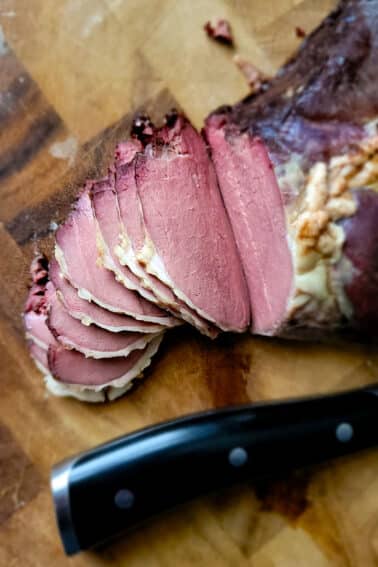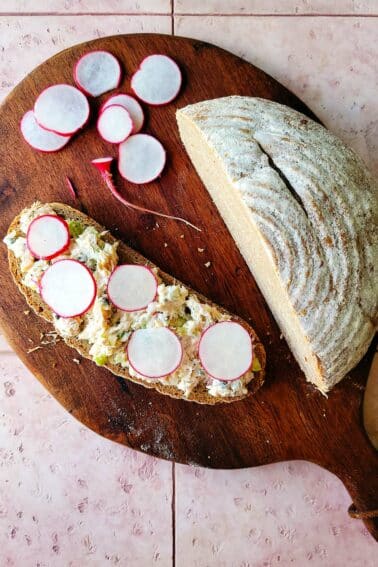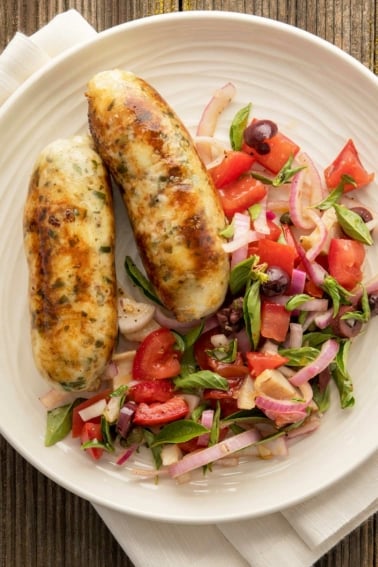As an Amazon Associate I earn from qualifying purchases.
Cumberland sausage is a classic English fresh sausage flavored simply with mace, sage and pepper. Normally pork, you can use other meats, too. I mixed venison with pork.

Making your own Cumberland sausage is easy: This recipe doesn’t have a ton of ingredients, no nitrites or starters, it’s not smoked, and it’s a coarse grind.
Similar to South African boerewors, Cumberland sausage is made and eaten in a coil, not links. You can pan sear the coil, roast it, slice it in chunks, or, my favorite, grill it. The technique is to skewer the coil twice so you can flip the sausage on the grill easily.
Oh, and the name? It’s from the part of England where Cumberland sausage comes from. It’s the far northwest corner, just under Scotland.
This is a good, basic sausage to learn if you are a beginner. Start by reading my tutorial on how to make sausage, then this recipe will be a snap.
Since Cumberland is a coarsely ground sausage, you will want to start with meat and fat that is mostly free of silverskin and connective tissue, otherwise it can be unpleasantly chewy. If that’s the only sort of meat you have on hand, grind it twice.
I prefer a 7 mm die for this sausage, but you could use anything from 5 mm to 9 mm. If you’re using a grinder that has limited grinder plates, use the “coarse” one, which is usually 6 mm.
An actual Cumberland sausage will be 100 percent pork, but since I am a hunter, I use 50-50 pork and venison. If you do this, make sure the pork is very fatty. You’re looking for about 20 percent fat.
You can, if you want, use grain as a binder; this is common in Britain. Breadcrumbs are a good option, but you can also use flaked rice or even potato starch. I don’t use a ton because, unlike British bangers, these sausages rely less on grain as a binder.

How to Eat Cumberland Sausage
Mostly you’ll see people cooking the entire coil of Cumberland sausage, then slicing off portions from there and serving them with gravy and mashed potatoes or other root vegetables.
You can also cut the coil and put the sausage into any sort of mixed roast with vegetables, or grill the sausage, slice off a link and put it in a bun, or hell, just use it as the base for chili or a pasta sauce.
Cumberland is that versatile.
It’ll keep a week in the fridge, and it freezes well. I’d cut it into portions before freezing.
If you liked this recipe, please leave a ⭐️⭐️⭐️⭐️⭐️ rating and a comment below; I’d love to hear how everything went. If you’re on Instagram, share a picture and tag me at huntgathercook.
Cumberland Sausage
Ingredients
- 5 pounds pork shoulder or other fatty pork (see below for options)
- 33 grams salt, about 2 tablespoons
- 1 cup dry breadcrumbs
- 1 tablespoon minced fresh sage
- 1/2 teaspoon mace or ground nutmeg
- 1/2 teaspoon white pepper
- 1/2 teaspoon black pepper
- 3/4 cup ice water
- sausage casings, about 6 feet's worth
Instructions
- Flush the casings with warm water and keep them in a bowl of warm water.
- Cut the meat and fat into pieces that will fit into your grinder. If you have time, mix this with the salt and put in a covered container in the fridge overnight. This will help improve the bind. But you can skip this if you are in a hurry.
- Mix the meat and fat with all the remaining spices; save the breadcrumbs and water for later. Grind through a coarse die, between 5 mm and 9 mm. If the meat has silverskin and connective tissue, grind twice.
- Make sure the mixture is below 40°F, and if it's not, chill until it is. Add the breadcrumbs and ice water and mix well for about 1 to 2 minutes. You'll see the sausage bind to itself and form one cohesive ball. You'll also see little whitish streaks on the sides of container you're mixing in.
- Put the meat in a sausage stuffer and carefully fill a coil of casing. You will want to do this slowly because unlike links, coils are harder to manipulate after stuffing to remove all the air pockets — so you want to minimize those air pockets in the first place.
- Let the sausage sit in the fridge for at least 1 hour before cooking, to give the breadcrumbs a chance to absorb moisture, which will help with the finished texture.
Notes
Nutrition
Nutrition information is automatically calculated, so should only be used as an approximation.






if you are using fatback or pork belly are you using a smoked product?
Teresa: No, fresh to frozen. Definitely not smoked.
Thank you for this recipe – I will be trying it. A ‘game changing’ tip for all of your sausage making followers – add half a teaspoon of baking sofa to the water you’re soaking your casings in. If you’ve made a few sausages, you’ll no doubt have experienced your casings binding to the stuffer horror blowing out (especially the more delicate sheep casings) and it can be VERY demoralising and frustrating. Try this and you’ll thank whoever the absolute genius is who ‘discovered’ this hack!
I have an allergy to pork is there another meat you would recommend?
Angela: This is always a pork sausage in Britain. But I suppose you could make it with beef and beef fat.
My wife and I made a batch of this sausage this last weekend. Used about half venison and half pork butt. Turned out very good. Thank you for your very helpful website. We also made the sweet Italian sausage which turned out great. Also used half venison half pork butt roast for that.
Hank. I’ve lost my recipe, 91 next week.
This is however for a secret ingredient. A local chef put me onto it.
It is dried apricots and the juicier the better. ie Aus.tralian
A couple of hand full for 25 lbs duck or goose
Have you used this recipe for ground goose? I have a Fowl Plucker and so can use the fresh skin of fatty birds too.
I’m in SE Missouri
My nephew is Jonathan Olson, a top snow goose hunter, killed over 750 birds one year. Guide, etc. from Grand Forks ND.
“Experts” say that you more likely will be diabetic if you eat more that one to two servings of meat with nitrates per week. Most sausages and jerky recipes seem to have curing salt, so I find this one very pleasing to try. May make some venison this way too.
What is the difference in using natural nitrates found in cherry or celery as used by Oscar Meyer meats in some hot dogs and other luncheon meats, as to curing salt products? Is that just a gimmick?
This sounds great and definitely simple compared to some of your other sausage recipes I’ve made. If I wish to freeze this in individual portions, should I twist it off to form links, rather than making it into the coil?
Goings to get a smoker this week. Been wanting to replace my one. This will be the first thing I make. I love making sausage with wild boar.